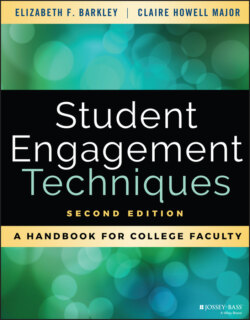Читать книгу Student Engagement Techniques - Elizabeth F. Barkley - Страница 40
A Perspective from Neuroscience
ОглавлениеNeuroscientists are making remarkable discoveries that help us understand what happens within our brains when we are learning. To better understand how learning occurs, it is useful to have at least a fundamental understanding of its neurological basis. There are now several books that explain the brain's functioning to educators and general audiences, and the following is a synthesis of information provided in several of these sources (Diamond & Hopson, 1998; Ratey, 2002; Sousa, 2006; Wlodkowski, 2008) as well as in Barkley, Major, and Cross (2014) and Cross (1999). The brain is comprised of cells called neurons. Neurons start out as round cell bodies, but then each cell body grows as many as 100,000 short branches called dendrites as well as a single long root known as an axon. Neurons act like tiny batteries, receiving information through the dendrites, sending it as a signal down the axon where chemicals called neurotransmitters are “fired” across a gap called the synapse to be received by the dendrites of another neuron. As the neurotransmitter enters the dendrites of a neighboring neuron, it sparks a series of electro-chemical reactions that cause the receiving neuron also to “fire” through its axon. The process and reactions continue in a sequence until there is a pattern of neuronal connections firing together.
Bombarded with thousands of stimuli that create these events every moment of our lives, neurons stay in a state of readiness for hours or even days. If the pattern is not stimulated again, the neuronal network will decay and the perception will be lost. This occurs so that our brain does not get cluttered with useless information. If, on the other hand, the pattern is repeated during this standby period and the associated network of neurons fires together again, the web of connections becomes more permanent. Each neuron and its thousands of neighbors intertwine to form an extraordinarily complex, interconnected tangle consisting of about 100 trillion constantly changing connections. Through repetition, some connections are strengthened and we “learn,” while connections that are seldom or never used are eliminated and we “forget.”
Thus, dendrites are the main way by which neurons get information (learn), the axon is the main way the neuron sends the information (teach), and everything we know and understand has been preserved as a network of neurons in our brain. When adults learn, we build on or modify networks that have been created through previous learning and experience. If the new information fits easily with the old information, it is said to be assimilated. If the new information challenges the existing information sufficiently that the existing structure needs to be revised, it is said to be accommodated (Svinicki, 2004, p. 11). The more dendrites an individual has on which to hang or attach new information, the easier it is to learn and retain new information. The greater number of basic neuronal networks an individual has, the easier it is to form more complex networks. From a neuroscientific viewpoint, therefore, learning is long-lasting change in neurons and existing neuronal networks. When we promote active learning, we are helping students grow dendrites as well as activate and build upon existing neuronal networks.
